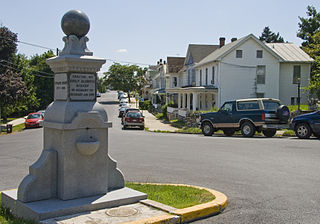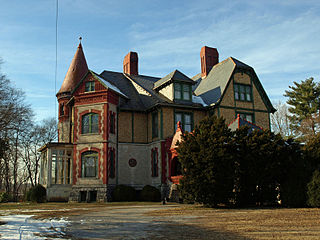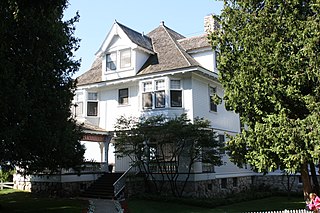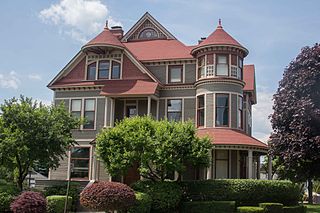
Hanes and Hanes Her Way is a brand of clothing.

The Marathon County Historical Museum is museum located in Wausau, Marathon County, Wisconsin, United States. It is located in the Cyrus Carpenter Yawkey House, a house listed on the National Register of Historic Places in 1974. The house is a significant example of Classical Revival architecture.

The Thomas D. Page House, also known later as the Belcher Lodge or the Chicopee Falls Masonic Temple, is a historic house in Chicopee, Massachusetts, USA. Built about 1875, it is a prominent local example of Queen Anne and Stick style architecture, built by one of the community's business leaders of the time. For many years it housed the local Masonic lodge. The house was listed on the National Register of Historic Places in 1988; it now houses an antiques business.

The Mrs. A. W. Gridley House is a Frank Lloyd Wright designed Prairie School home in Batavia, Illinois.

The Boomtown Historic District comprises the western and southern portions of Martinsburg, West Virginia, generally along the alignments of West King Street and Winchester Avenue, following the general path of the town's electric streetcar system. It includes a former industrial section of the town, home to a number of textile mills, as well as the housing that was built for mill workers.

The Baltimore and Ohio Related Industries Historic District comprises a portion of Martinsburg, West Virginia to either side of the Baltimore and Ohio Railroad line as it runs through the city. The district includes the Baltimore and Ohio Railroad Martinsburg Shops, a National Historic Landmark, and a variety of industrial and commercial concerns that depended on the railroad.

Greene Mansion is a historic home located at 92 Market Street in Amsterdam, Montgomery County, New York. It was built in 1881 as a residence for Henry Eckford Greene, who died two months after it was completed and never lived in it. Henry Greene was one of two sons of William Kimball Greene, who founded the Greene Knitting Mills, the first carpet factory in Amsterdam. The Greene family built a number of beautiful houses on Market Street, of which the Greene Mansion is one.

The Joseph H. Frisby House is a historic house located at 209 North 400 West in Provo, Utah. It is listed on the National Register of Historic Places.

Gordon Hall, also known as the Judge Samuel W. Dexter House, is a private house located at 8341 Island Lake Road in Dexter, Michigan. It was designated a Michigan State Historic Site in 1958 and listed on the National Register of Historic Places in 1972. The house is unique in Michigan for its balance, large scale, and massive hexastyle portico. The structure is also significant as the dwelling of Judge Samuel W. Dexter, a pioneering Michigan resident and land baron who had a substantial impact on early development of Washtenaw County and other sections of the state. The house was later owned by Dexter's granddaughter Katharine Dexter McCormick, a pioneering research scientist, suffragist, and philanthropist. In its early days, Gordon Hall hosted at least two, and possibly three United States presidents, and it was almost certainly a stop along the Underground Railroad.

The W. B. Davis Hosiery Mill is a historic industrial complex in Fort Payne, Alabama. It opened in 1884 in the midst of Fort Payne's economic boom, manufacturing building hardware and supplies. The main building, which features Colonial Revival details, is three stories tall, with 12-over-12 sash windows on each floor. An 85-foot (26-meter) chimney has a flared top and corbeled brick course, imitating a doric order column. By 1890, promises of plentiful and high-quality iron ore and other minerals were proven to be exaggerated. Eight of the largest manufacturers in town merged in a futile effort to avoid bankruptcy.

The Kildare–McCormick House is a historic residence in Huntsville, Alabama. The highly ornate, Queen Anne-style mansion was built in 1886–87. Its early owners contributed to the development of Huntsville, both through industrial projects and philanthropic efforts. The house was listed on the National Register of Historic Places in 1982.

The Merrimack Mill Village Historic District is a historic district in Huntsville, Alabama. The cotton mill was built in 1900 by the Merrimack Manufacturing Company, reaching a peak of 1,600 employees by 1955. The mill was sold in 1946, and became known as the Huntsville Manufacturing Company. It operated until 1989 and was torn down in 1992. Houses in the adjoining mill village were built between 1900 and 1937, and encompass many mill house styles not commonly seen outside New England. The district was listed on the National Register of Historic Places in 2010.

The Busiel-Seeburg Mill is a historic mill building in Laconia, New Hampshire, since converted into an office building known as 1 Mill Plaza. This 3-1/2 story brick structure achieved its present configuration in stages, beginning in 1853, and successively altered and expanded through the rest of the 19th century. The business, established by John W. Busiel in 1846, manufactured knitted hosiery, and was one of the first producers of knitwear to use circular knitting machines invented by Aiken and Peppers. The building was listed on the National Register of Historic Places in 1971.

The Lehoullier Building is a historic mill tenement house at 161-169 Main Street in Somersworth, New Hampshire. Built in 1843, it is one of two surviving tenement houses of the many that once lined Main Street near the Great Falls Manufacturing Company. The building was listed on the National Register of Historic Places in 1979.

The Arthur R. Hoard House, also known as the George P. Marston House, is a historic residence in Fort Atkinson, Wisconsin, United States. The house was owned by several important early families in the town, including two mayors and a state representative.

The Charles W. Goodyear House is located at 888 Delaware Avenue in Buffalo, New York, part of the Delaware Avenue Historic District, a federally designated historic district listed on the National Register of Historic Places since 1974. The Châteauesque house was designed by prominent Buffalo architect Edward Green, of the Buffalo architecture firm Green & Wicks, and was completed in 1903 at a cost of $500,000. The home was built for Charles and Ella Goodyear. Goodyear was a founder and head of several companies including the Buffalo and Susquehanna Railroad, Great Southern Lumber Company, and the New Orleans Great Northern Railroad Company, as well as a director of Marine National Bank, and General Railway Signal.
Kilbourn or Kilborn may refer to:

The Michigan Governor's Summer Residence, also known as the Lawrence A. Young Cottage, is a house located at the junction of Fort Hill and Huron roads on Mackinac Island, Michigan. It was listed on the National Register of Historic Places in 1997.

The Horatio N. Hovey House is a private house located at 318 Houston Avenue in Muskegon, Michigan. It was listed on the National Register of Historic Places in 1983.

The James McColl House is a private house located at 205 S. Main Street in Yale, Michigan. It was listed on the National Register of Historic Places in 1985.






















